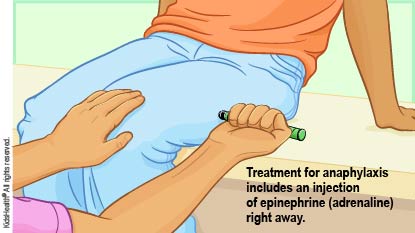Anaphylaxis is a sudden, life-threatening reaction that is usually caused by an allergy. The most common allergens (things that cause a reaction) are foods, medications, and insect stings.
More to Know
Anaphylaxis does not occur the first time someone comes in contact with an allergen. During the first exposure, the person's immune system, which fights infections and disease, responds to the allergen as if it were a threat. When exposed to the allergen again, the person's body tries to "defend" itself by releasing chemicals into the blood that cause inflammation throughout the body and the severe allergic symptoms known as anaphylaxis.
Common anaphylaxis symptoms are itchy or red skin, swelling, trouble breathing, hoarseness, a runny or stuffed nose, throwing up, a fast heartbeat, or passing out. If someone has anaphylaxis more than once, signs may change each time.
Treatment for anaphylaxis includes an injection of epinephrine (adrenaline) right away. Other medications like prednisone (a steroid) and antihistamines treat the reaction and usually will be continued for a few days. With prompt treatment, an episode usually ends within an hour, but some can last longer. Sometimes symptoms return without another exposure to the allergen, usually within 10 hours but sometimes up to 3 days later.

Keep in Mind
Anaphylaxis can be life threatening, so anyone at risk for it (and all caretakers) should know what to do in an emergency.
Note: All information is for educational purposes only. For specific medical advice, diagnoses, and treatment, consult your doctor.
© 1995-2024 KidsHealth ® All rights reserved. Images provided by iStock, Getty Images, Corbis, Veer, Science Photo Library, Science Source Images, Shutterstock, and Clipart.com

